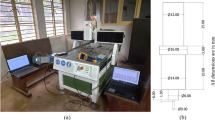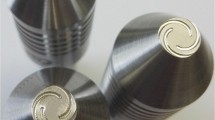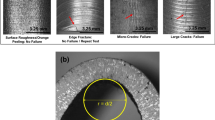Abstract
In this study, 2014 aluminum alloy sheets with 1 mm thickness are welded successfully by friction stir welding (FSW) robot under the condition of high rotation speed. When the high rotation speed of 10,000-16,500 rpm is applied, the lower axial pressure (less than 200 N) is obtained, which reduces stiffness requirements for equipment. Welding deformation is inevitable because high rotation speed can easily result in rapid heating rate and uneven heat input. The welding distortion caused by two cooling methods is measured, respectively, by laser range finder. The experimental results show that the welding distortion is smaller under the condition of water cooling. When the rotation speed is up to 15,000 rpm and welding speed 50-170 mm/min, the whole welding process is controllable. Under the higher rotation speed condition, the welding defects disappear gradually and more stable mechanical properties can be obtained up to 75% of base metal (ω = 16,000 rpm, ν = 110 mm/min). The results of different welding parameters demonstrate that the high rotation speed can increase material mixing and reduce the axial force (z force), and it can benefit lightweight sheet welding by using FSW robot.

















Similar content being viewed by others
References
S. Rajakumar, C. Muralidharan, and V. Balasubramanian, Establishing Empirical Relationships to Predict Grain Size and Tensile Strength of Friction Stir Welded AA 6061-T6 Aluminium Alloy Joints, Trans. Nonferrous Met. Soc. China, 2010, 20, p 1863–1872
G. Çam and S. Mistikoglu, Recent Developments in Friction Stir Welding of Al-Alloys, J. Mater. Eng. Perform., 2014, 23, p 1936–1953
G. Çam, Friction Stir Welded Structural Materials: Beyond Al-Alloys, Int. Mater. Rev., 2011, 56(1), p 1–48
H. Su, C.S. Wu, A. Pittner, and M. Rethmeier, Simultaneous Measurement of Tool Torque, Traverse Force and Axial Force in Friction Stir Welding, J. Manuf. Proc., 2013, 15, p 495–500
H. Zhang, M. Wang, W. Zhou, X. Zhang, Z. Zhu, T. Yu et al., Microstructure–Property Characteristics of a Novel Non-weld-Thinning Friction Stir Welding Process of Aluminum Alloys, Mater. Des., 2015, 86, p 379–387
P.J. Ramulu, R.G. Narayanan, S.V. Kailas, and J. Reddy, Internal Defect and Process Parameter Analysis During Friction Stir Welding of Al 6061 Sheets, Int. J. Adv. Manuf. Technol., 2012, 65, p 1515–1528
M. Guillo and M. Dubourg, Impact & Improvement of Tool Deviation in Friction Stir Welding: Weld Quality & Real-Time Compensation on an Industrial Robot, Robot. Comput. Integr. Manuf., 2016, 39, p 22–31
X.J. Wang, D.B. Han, and Z.K. Zhang, Measurements and Influencing Factors of Longitudinal Force of Pin Tools in Friction Stir Welding Process, Weld. Joining, 2008, 9, p 22–25
X. Cao and M. Jahazi, Effect of Tool Rotational Speed and Probe Length on Lap Joint Quality of a Friction Stir Welded Magnesium Alloy, Mater. Des., 2011, 32, p 1–11
D.Q. He, S.P. Li, J. Li, and S. He, Friction Stir Welding of 2024-T4 Aluminum Alloy Plate with 1.8 mm Thickness, Hot Work. Technol., 2011, 40, p 112
H.H. Zhao, X.S. Feng, Y.Y. Xiong, G.Y. Su, L. Hu, and L.J. Guo, Microstructure and Properties of Micro Friction Stir Welded Joint of Al-Alloy Ultra Thin Plate with Zero Tilt Angle, Trans. China Weld. Inst., 2014, 35, p 47–51
G.L. Qin, K. Zhang, W.B. Zhang, and C.S. Wu, Effect of Friction Stir Welding Heat Input on Weld Appearance and Mechanical Properties of 6013-T4 Al Alloy Joint, Trans. China Weld. Inst., 2010, 31, p 5–8
D.Y. Yan, Q.Y. Shi, W.U. Aiping, J. Silvanus, Y. Liu, T. University et al., Numerical Analysis on the Residual Distortion of Al Alloy Sheet After Friction Stir Welding, Acta Metall. Sin., 2009, 45, p 183–188
Z. Zhang, B.L. Xiao, and Z.Y. Ma, Influence of Water Cooling on Microstructure and Mechanical Properties of Friction Stir Welded 2014Al-T6 Joints, Mater. Sci. Eng., A, 2014, 614, p 6–15
D.Q. He and D.H. Li, Process Research and Microstructure Analysis on Friction-Stir Welding for LF21 Sheet, Alum. Fabr., 2008, 2, p 35–38
S. Chen, H. Li, S. Lu, R. Ni, and J. Dong, Temperature Measurement and Control of Bobbin Tool Friction Stir Welding, Int. J. Adv. Manuf. Technol., 2016, 86, p 337–346
Y.H. Zhao, J.D. Liu, L.N. Zhang, Z.S. Sun, and G.Q. Wang, Study on Friction Plug Welding of 2014 Aluminum Alloy FSW Joint, J. Aeronaut. Mater., 2010, 30, p 41–46
Y.H. Zhao, S.B. Lin, L. Wu, and F.X. Qu, The Influence of Pin Geometry on Bonding and Mechanical Properties in Friction Stir Weld 2014 Al Alloy, Mater. Lett., 2005, 59, p 2948–2952
I. Galvão, R.M. Leal, D.M. Rodrigues, and A. Loureiro, Influence of Tool Shoulder Geometry on Properties of Friction Stir Welds in Thin Copper Sheets, J. Mater. Process. Technol., 2013, 213, p 129–135
Z. Zhang and H.J. Liu, Effect of Pin Shapes on Material Deformation and Temperature Field in Friction Stir Welding, Hanjie Xuebao Trans. China Weld. Inst., 2011, 32, p 5–8
M.I. Costa, D. Verdera, J.D. Costa, C. Leitao, and D.M. Rodrigues, Influence of Pin Geometry and Process Parameters on Friction Stir Lap Welding of AA5754-H22 Thin Sheets, J. Mater. Process. Technol., 2015, 225, p 385–392
M. Pakdil, G. Çam, M. Koçak, and S. Erim, Microstructural and Mechanical Characterization of Laser Beam Welded AA6056 Al-Alloy, Mater. Sci. Eng. A, 2011, 528, p 7350–7356
G. Çam, V. Ventzke, J.F.D. Santos, M. Koçak, G. Jennequin, P. Gonthier-Maurin, M. Penasa, and C. Rivezla, Characterization of Laser and Electron Beam Welded Al-Alloys, Prakt. Metallogr., 2000, 37, p 59–89
G. Çam, V. Ventzke, J.F.D. Santos, M. Koçak, G. Jennequin, and P. Gonthier-Maurin, Characterisation of Electron Beam Welded Aluminium Alloys, Sci. Technol. Weld. Joining, 1999, 4(5), p 317–323
F.C. Liu and Z.Y. Ma, Influence of Tool Dimension and Welding Parameters on Microstructure and Mechanical Properties of Friction-Stir-Welded 6061-T651 aluminum alloy, Metall. Mater. Trans. A, 2008, 39, p 2378–2388
J.C. Song, L.Y. Ye, X.M. Zhang, D.Q. He, and H.P. Li, Influence of Cooling Conditions on Joint Properties of 2519A Aluminum Alloy by Friction Stir Welding, J. Cent. South Univ., 2012, 43(10), p 3801–3806
Acknowledgments
This research was sponsored by Qing Lan Project and the National Natural Science Foundation of China (51675248, 51375218 and 51405206) and the Natural Science Fund of the Jiangsu Higher Education Institutions of China (15KJB460009).
Conflict of interests
The authors declare that they have no conflict of interests to this work.
Author information
Authors and Affiliations
Corresponding authors
Rights and permissions
About this article
Cite this article
Chen, S., Zhou, Y., Xue, J. et al. High Rotation Speed Friction Stir Welding for 2014 Aluminum Alloy Thin Sheets. J. of Materi Eng and Perform 26, 1337–1345 (2017). https://doi.org/10.1007/s11665-017-2524-y
Received:
Revised:
Published:
Issue Date:
DOI: https://doi.org/10.1007/s11665-017-2524-y




